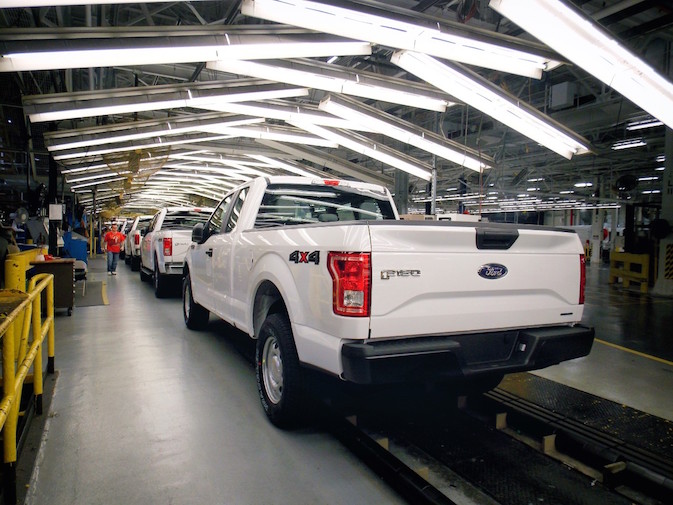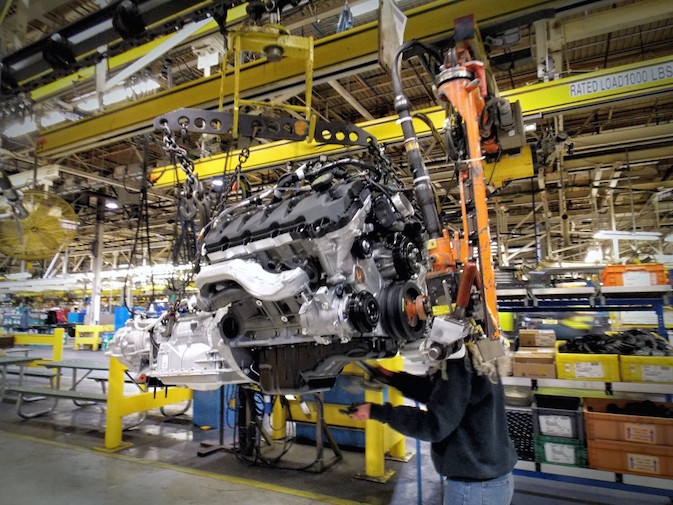
Ab sofort können in den USA eine ganze Reihe von Trucks direkt mit Gasantrieb geordert werden. In dieser Klasse und für die US-Autoindustrie neu, bietet Ford den Werkseinbau von Gasanlagen an. Für Importeure sicher sehr interessant. Hier in Deutschland lassen sich die teils großen Benziner deutlich besser mit Gasantrieb verkaufen. Problem war bisher immer die korrekte Umrüstung und der einwandfreie Betrieb. Das ist mit dieser Maßnahme nun wesentlich einfacher. Ford erkennt hier mE. die Entwicklung, Dieselmaschinen nur noch im Schwerlastbereich einzusetzen. Gerade das VW-Dieselgate ließ klar werden, dass Dieselmaschinen in PKW’s nicht mehr zeitgemäß sind. Der Dieselmotor hat im Gegensatz zum Benziner kaum noch Potenzial in den Bereichen Umweltfreundlichkeit oder Treibstoffverbrauch. Hier wird der Benziner in den nächsten Jahren mindestens 15% Ersparnis durch neue Technologien und Materialien realisieren.

DEC 9, 2015 | KANSAS CITY
KANSAS CITY, Dec. 9, 2015 – The first 2016 Ford F-150 with the ability to run on clean-burning compressed natural gas has rolled off the assembly line, making Ford – America’s truck leader – the only manufacturer to offer a CNG/propane-capable half-ton pickup.
The 2016 Ford F-150 with 5.0-liter Ti-VCT V8 engine is available with a factory-installed, gaseous-fuel prep package that includes hardened valves, valve seats, pistons and piston rings so it can operate on natural gas, propane or gasoline through separate fuel systems.
“It’s exciting to see the first F-150s with the CNG/propane-prepped 5.0-liter V8 headed to customers,” said Jon Coleman, Ford fleet sustainability and technology manager. “Whether running on gasoline, gaseous fuel or both, the 5.0-liter V8 F-150 offers hardworking customers terrific towing and payload and now, the ability to operate on alternative fuel.”
When equipped with a bi-fuel CNG/propane engine package, the 5.0-liter V8 F-150 is capable of achieving more than 750 miles on combined tanks of gasoline and CNG, depending on tank size. The Ford F-150 with 5.0-liter V8 has an EPA-estimated rating of 22 mpg on the highway and 18 mpg combined.
Green Car Journal recently named the 2016 F-150 its 2016 Green Truck of the Year™, in part due to the availability of the gaseous-fuel prep option.
CNG/LPG engine prep from the factory costs $315 before the customer chooses a Ford Qualified Vehicle Modifier to supply fuel tanks, fuel lines and unique fuel injectors. Upfits run approximately $6,000 to $9,500, depending on fuel tank capacity.
Ford offers broadest portfolio of CNG/propane-capable vehicles
With production of the 2016 F-150 now under way, Ford Motor Company offers eight factory-available vehicles with a gaseous-fuel prep option – more than any other North American automaker. In addition to F-150 with 5.0-liter Ti-VCT V8, these include:
Benefits of compressed natural gas and propane
Compressed natural gas is mainly comprised of methane. It is stored and distributed in hard containers at a pressure of around 3,600 psi. Approximately 85 percent of the CNG used in the United States is produced domestically.
Another benefit of this alternative fuel is cleaner emissions. A vehicle operating on CNG can reduce tailpipe CO2emissions by approximately 20 percent compared with the same vehicle running on gasoline.
Propane autogas, also known as liquefied petroleum gas, is a mixture of hydrocarbon gases, most commonly propane and butane. Approximately 90 percent of the United States’ propane supply is produced domestically.

 Stumblen
Stumblen Diggen
Diggen Tweeten
Tweeten
Keine Kommentare
Du mußt eingeloggt sein um zu kommentieren.